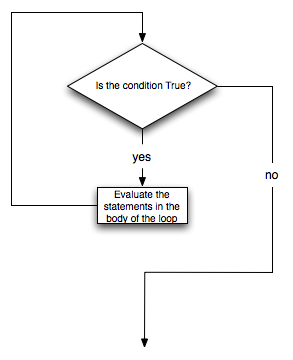3. The while Statement¶
There is another Python statement that can also be used for iteration. It is called the while statement or a while loop. The while statement provides a much more general mechanism for iterating. Similar to the if statement, it uses a boolean expression to control the flow of execution. The body of the while loop will be repeated as long as the controlling boolean expression evaluates to True.
The following figure shows the flow of control.

We can use the while loop to create any type of iteration we wish, including anything that we have previously done with a for loop. For example, the program in the previous section could be rewritten using while by taking the following steps.
Instead of relying on the range function to produce the numbers for our summation, we will need to produce them ourselves. To do this, before entering the while loop, we will create the variable called num and initialize it to 1, the first number in the summation. Every iteration will add num to the running total, and increment num to the next value, until all the desired values have been used.
In order to control the iteration, we must create a boolean expression that evaluates to True as long as we want to keep adding values to our running total. In this case, as long as num is less than or equal to the upper bound, we should keep going.
Here is a new version of the summation program that uses a while statement.
You can almost read the while statement as if it were in natural language. It means, while num is less than or equal to n, continue executing the body of the loop. Within the body, each time the loop executes, update sum using the accumulator pattern and increment num. After the body of the loop finishes, we go back up to the condition of the while and reevaluate it. When num becomes greater than n, the condition fails to be True and flow of control continues to the return statement, the next statement outside the while loop.
The same program in codelens will allow you to observe the flow of execution.
(iteration_while2)
Here is the flow of execution for a while statement:
- Evaluate the condition, which yields a value of
FalseorTrue. - If the condition is
False, exit thewhilestatement and continue execution at the next statement after the loop body. - If the condition is
True, execute the statements in the body and then go back to step 1.
The body consists of all of the statements below the header and indented at least 4 spaces in from the header of the while loop.
This type of flow is called a loop because the third step loops back around to the top. Notice that if the condition is False the first time through the loop, the statements inside the loop are never executed.
The body of the loop should change the value of one or more variables so that eventually the condition becomes False and the loop terminates. Otherwise the loop will repeat forever. When this happens, the loop is called an infinite loop.
Question
Is it possible for a for loop to be an infinite loop?
Infinite loops are ubiquitous in programming — every programmer accidentally writes one from time to time. They’re such an established part of computer science history and culture that Apple named the street connecting the buildings on its corporate campus “Infinite Loop”.

In the code shown above, if we had forgotten to increment the value of num within the loop body, we would wind up with an infinite loop. As it stands, however, we can prove that the loop terminates because we know that the value of n is finite, and we can see that the value of num increments each time through the loop, so eventually it will have to exceed n. In other cases, it is not so easy to tell.
The for statement will always iterate through a sequence of values like a list of names or a list of numbers created by range. Since we know that it will iterate once for each value in the collection, it is often said that a for loop creates a definite iteration because we definitely know how many times we are going to iterate.
On the other hand, the while statement is dependent on a condition that needs to evaluate to False in order for the loop to terminate. Since we do not necessarily know when (of even if) this will happen, it creates what we call indefinite iteration. Indefinite iteration simply means that we don’t know how many times we will repeat. We expect that eventually the condition controlling the iteration will evaluate to False and the iteration will stop. (Unless we have an infinite loop, which is the problem we want to avoid.)
What you will notice here is that the while loop is more work for you, the programmer, than the equivalent for loop. When using a while loop you have to control the loop variable yourself. You give it an initial value, test for completion, and then make sure you update the program state in the body so that the loop eventually terminates.
So why have two kinds of loops if for looks easier? The short answer is that there are times when your program won’t know, in advance of runtime, how many iterations it will need to perform. Later in this chapter we will see an example of indefinite iteration where we need this extra power we get from the while loop. But first, let’s check your understanding.
Check your understanding
-
True or False: You can rewrite any
- True
- Although the while loop uses a different syntax, it is just as powerful as a for loop and often more flexible.
- False
- Often a for loop is more natural and convenient for a task, but that same task can always be expressed using a while loop.
for loop as a while loop.
- n starts at 10 and is incremented by 1 each time through the loop, so it will always be positive
- The loop will run as long as n is positive. In this case, we can see that n will never become non-positive.
- answer starts at 1 and is incremented by n each time, so it will always be positive
- While it is true that answer will always be positive, answer is not considered in the loop condition.
- You cannot compare n to 0 in a while loop. You must compare it to another variable.
- It is perfectly valid to compare n to 0. Though indirectly, this is what causes the infinite loop.
- In the while loop body, we must set n to False, and this code does not do that.
- The loop condition must become False for the loop to terminate, but n by itself is not the condition in this case.
The following code contains an infinite loop. Which is the best explanation for why the loop does not terminate?
n = 10
answer = 1
while n > 0:
answer = answer + n
n = n + 1
print(answer)